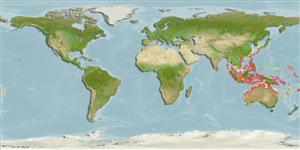>
Gobiiformes (Gobies) >
Gobiidae (Gobies) > Gobiinae
Etymology: Fusigobius: Latin, fusus = spindle + Latin, gobius = gudgeon (Ref. 45335); melacron: Named for the dark upper part of the dorsal fin.
More on author: Randall.
Environment: milieu / climate zone / depth range / distribution range
Ecologia
marino demersale; distribuzione batimetrica 7 - 31 m (Ref. 90102). Tropical
Indo-West Pacific.
Size / Peso / Age
Maturity: Lm ? range ? - ? cm
Max length : 3.5 cm SL maschio/sesso non determinato; (Ref. 41649); 3.6 cm SL (female)
Short description
Chiavi di identificazione | Morfologia | Morfometria
Spine dorsali (totale) : 6 - 7; Raggi dorsali molli (totale) : 10; Spine anali: 1; Raggi anali molli: 9. Characterized by semi-translucent grey with numerous small yellowish brown or dusky orange-red spots; presence of series of larger dark blotches along back; brown to blackish outer half of first dorsal fin; pelvic fins united only at base; absence of pelvic frenum; rounded caudal fin; longitudinal scale series 27; ctenoid scales except cycloid on breast, base of pectoral fin and few scales on side of nape; operculum without scales; median predorsal scales absent; opening of gill extending to below rear edge of preopercle; depth of body 4.7-5.2 in SL (Ref. 90102).
Inhabits sand-rubble bottoms next to reefs in 7-31 m (Ref. 90102).
Life cycle and mating behavior
Maturità | Riproduzione | Deposizione | Uova | Fecundity | Larve
Randall, J.E., 2001. Five new Indo-Pacific gobiid fishes of the genus Coryphopterus. Zool. Stud. 40(3):206-225. (Ref. 41649)
IUCN Red List Status (Ref. 130435: Version 2024-2)
Threat to humans
Harmless
Human uses
Pesca: pesca di sussistenza
Strumenti
Special reports
Download XML
Fonti Internet
Estimates based on models
Preferred temperature (Ref.
123201): 24.9 - 29, mean 28.1 °C (based on 392 cells).
Phylogenetic diversity index (Ref.
82804): PD
50 = 0.5005 [Uniqueness, from 0.5 = low to 2.0 = high].
Bayesian length-weight: a=0.00724 (0.00339 - 0.01546), b=3.10 (2.92 - 3.28), in cm total length, based on LWR estimates for this (Sub)family-body shape (Ref.
93245).
Trophic level (Ref.
69278): 3.2 ±0.3 se; based on size and trophs of closest relatives
Resilienza (Ref.
120179): Alto, tempo minimo di raddoppiamento della popolazione meno di 15 mesi (Preliminary K or Fecundity.).
Fishing Vulnerability (Ref.
59153): Low vulnerability (10 of 100).
Nutrients (Ref.
124155): Calcium = 826 [402, 2,397] mg/100g; Iron = 2.21 [1.13, 4.78] mg/100g; Protein = 16.9 [15.0, 18.6] %; Omega3 = 0.173 [0.062, 0.428] g/100g; Selenium = 41.7 [16.3, 109.6] μg/100g; VitaminA = 38.1 [9.8, 152.2] μg/100g; Zinc = 3.24 [2.02, 5.21] mg/100g (wet weight);
